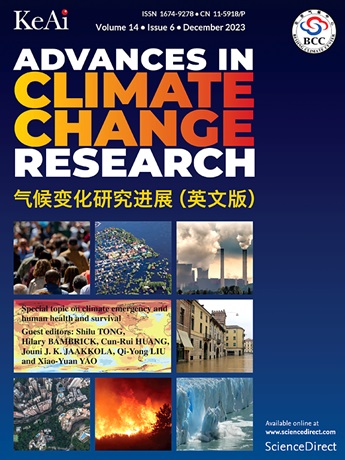The sensitivity of the Asian summer monsoon simulation to horizontal resolution and air‒sea coupling in the FGOALS-f climate system model
IF 5.2
1区 地球科学
Q1 ENVIRONMENTAL SCIENCES
引用次数: 0
Abstract
The relative importance between horizontal resolution and air‒sea coupling on improving Asian summer monsoon (ASM) simulation skill remains unclear. In this study, we investigated the sensitivity of ASM to horizontal resolution and air‒sea coupling via simulations using a series of versions of the FGOALS-f model. The possible causes of bias are further analyzed. The results show that the Atmospheric Model Intercomparison Project (AMIP) run of high model resolution (25 km) achieves the highest skill on capturing ASM pattern, while the AMIP run of low model resolution (100 km) appears the lowest skill. Further analysis of the hydrological cycle and monsoon dynamics suggested that the simulation of the vertical moisture transport term was the primary contributor to excessive precipitation over the western Pacific. In addition, the excessive release of latent heat and strong ASM circulation are also responsible for the strong precipitation intensity in the AMIP simulation. Importantly, although the air‒sea coupled simulation exhibited the higher skill level, the simulated sea surface temperature (SST) exhibited an overall cold bias. This cold bias partly counteracted excessive moisture transport after air‒sea interaction is considered. Thus, increasing resolution could be helpful for more accurate simulation of advection, and together with the use of prescribed observed daily SST could play more important roles than only considering air‒sea coupling on improving ASM simulations.
FGOALS-f气候系统模式下亚洲夏季风模拟对水平分辨率和海气耦合的敏感性
水平分辨率和海气耦合对提高亚洲夏季风模拟水平的相对重要性尚不清楚。在这项研究中,我们通过使用一系列版本的FGOALS-f模型进行模拟,研究了ASM对水平分辨率和海气耦合的敏感性。进一步分析了产生偏倚的可能原因。结果表明,高模式分辨率(25 km)的大气模式比对项目(AMIP)对ASM模式的捕获能力最强,而低模式分辨率(100 km)的AMIP捕获能力最低。进一步的水文循环和季风动力学分析表明,垂直水汽输送项的模拟是西太平洋过度降水的主要原因。此外,潜热的过度释放和强ASM环流也是造成AMIP模拟中强降水强度的原因。重要的是,虽然海气耦合模拟表现出更高的技能水平,但模拟的海表温度(SST)总体上表现出冷偏。这种偏冷部分抵消了海气相互作用后的过量水分输送。因此,提高分辨率有助于更准确地模拟平流,并且与使用规定的日观测海温一起使用比仅考虑海气耦合对改进ASM模拟更重要。
本文章由计算机程序翻译,如有差异,请以英文原文为准。
求助全文
约1分钟内获得全文
求助全文
来源期刊

Advances in Climate Change Research
Earth and Planetary Sciences-Atmospheric Science
CiteScore
9.80
自引率
4.10%
发文量
424
审稿时长
107 days
期刊介绍:
Advances in Climate Change Research publishes scientific research and analyses on climate change and the interactions of climate change with society. This journal encompasses basic science and economic, social, and policy research, including studies on mitigation and adaptation to climate change.
Advances in Climate Change Research attempts to promote research in climate change and provide an impetus for the application of research achievements in numerous aspects, such as socioeconomic sustainable development, responses to the adaptation and mitigation of climate change, diplomatic negotiations of climate and environment policies, and the protection and exploitation of natural resources.
 求助内容:
求助内容: 应助结果提醒方式:
应助结果提醒方式:


